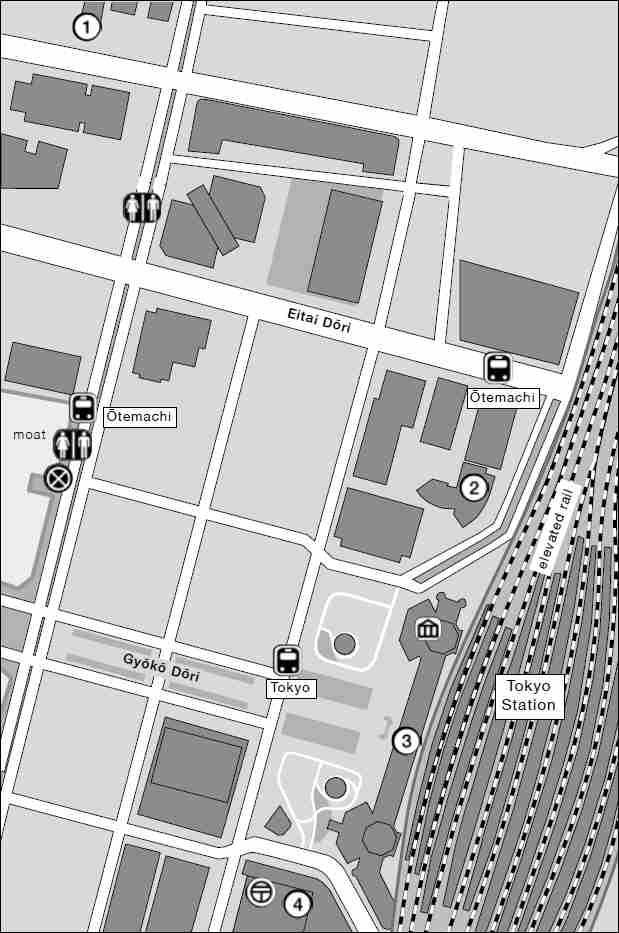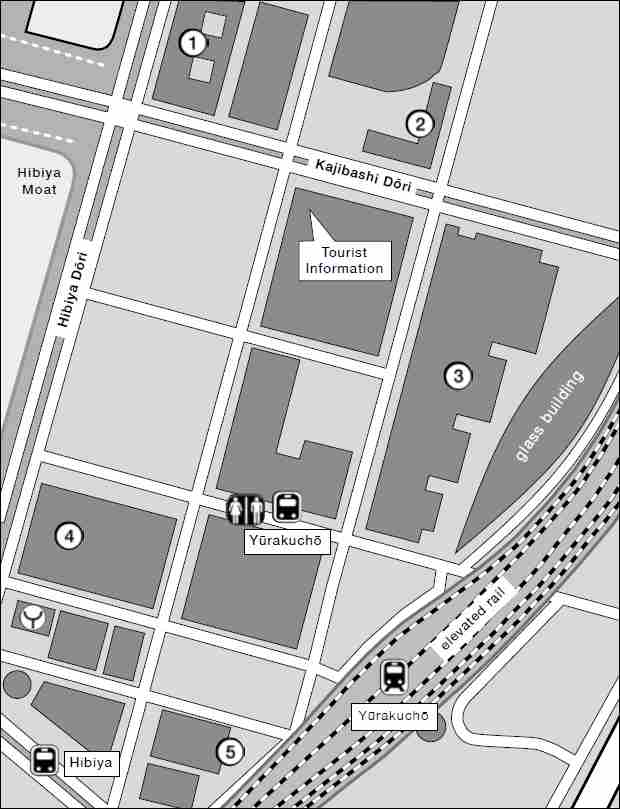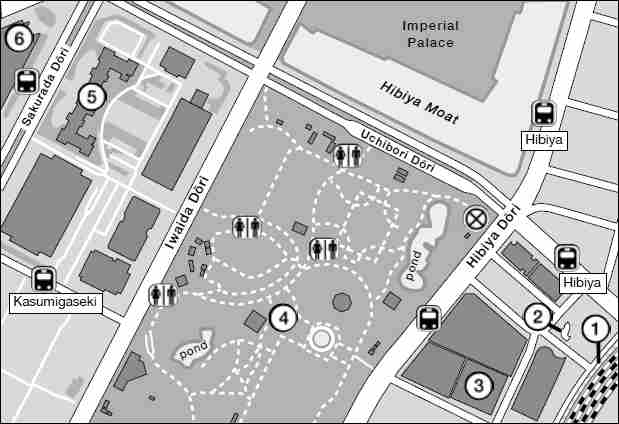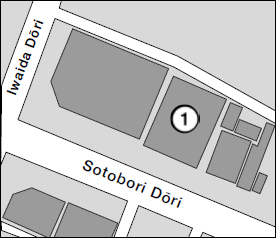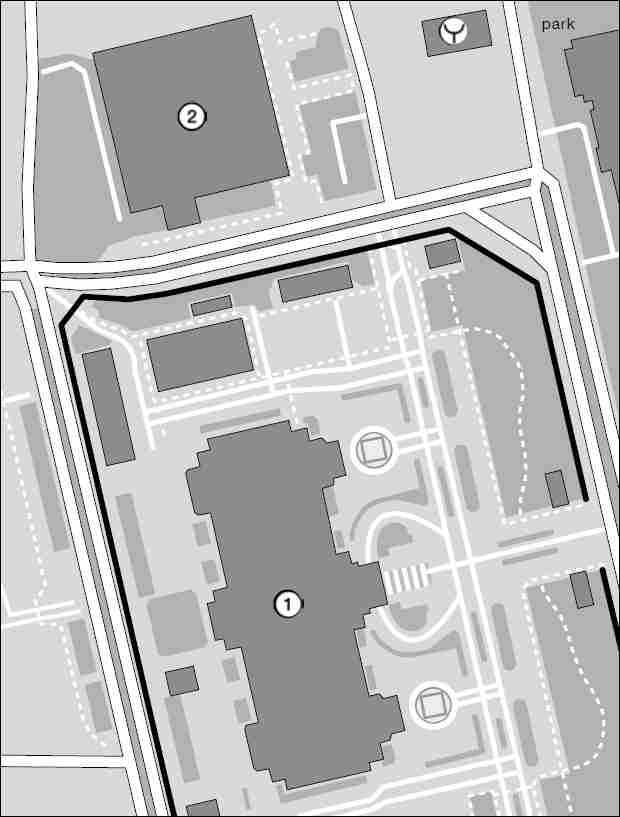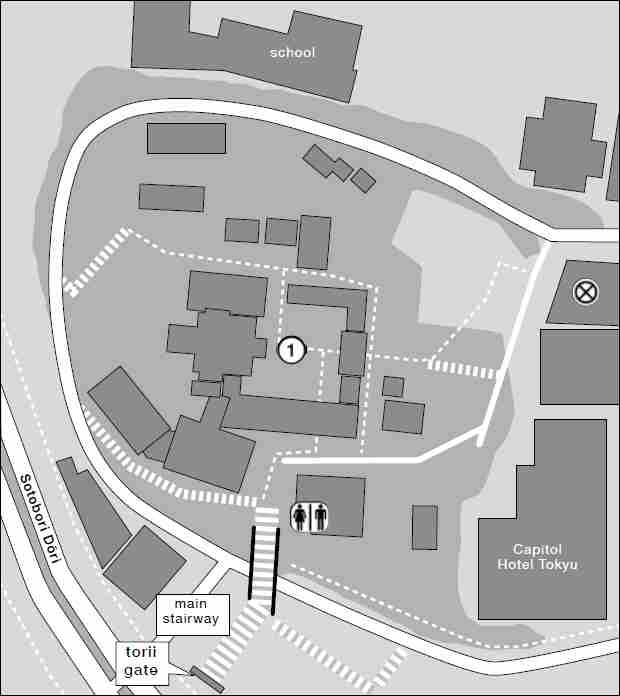丸の内 • 永田町
MARUNOUCHI TO NAGATACHŌ
This chapter covers the areas east and south of the Imperial Palace grounds. In the Edo period this area was filled with government offices and the residences of the daimyō closest to the Tokugawa family. Marunouchi specifically means “within the moats,” while Nagatachō was on the higher ground adjacent to it, just outside Sakurada Mon. A suggested route here is to start at the top of detail map 1 and work your way south to where detail map 2 is.
DETAIL 1
This is a mound that was raised over the head of Taira no Masakado. Masakado was a 10th-century samurai leader who, due to conflicts with relatives and his inability to obtain legal support, attacked a government outpost, which led to his being declared a rebel. After a period of warfare he was defeated and killed. Masakado’s head was taken to Kyoto and hung on a tree as a warning against rebellion. However, the head disappeared and legend has it wandering the Kantō looking for its body. Eventually it landed near the village of Shibasaki where the locals buried it, raised a mound over the burial spot, and asked the spirit of Masakado to become a guardian of the area. The mound collapsed in the Great Kantō Earthquake and what remains is a well-cared for monument on the location. The first time I visited, a man in a business suit came, placed a few offerings, and prayed. Then a young man in worker’s overalls arrived, put down bags of rice, bottles of tea, and other items, and then prayed in a very ritualistic manner. A tradition from the Edo period is that if you visit the mound, or Kanda Myōjin where Masakado is also enshrined, you never visit the temple Narita Fudōson, as the main statue there was brought to the region for rituals against Masakado.
An account of Masakado’s rebellion was written not long after the events and is available in English as Shōmonki: The Story of Masakado’s Rebellion.
MARUNOUCHI TO NAGATACHŌ
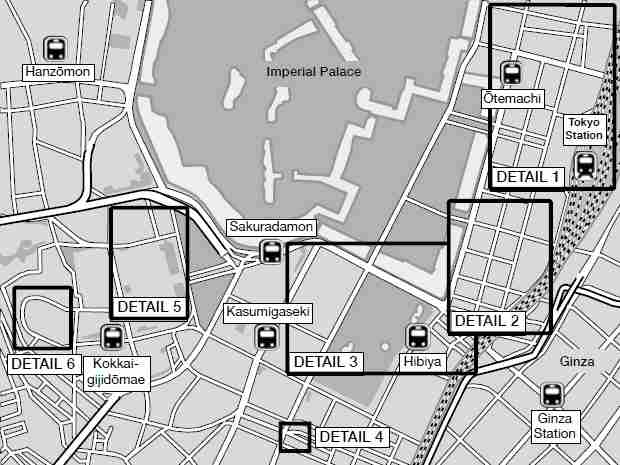
MARUNOUCHI TO NAGATACHŌ DETAIL 1
This bookshop located in the Marunouchi Oazo building is one of my favorite in Tokyo and my favorite Maruzen bookshop. There are four stories of books and magazines to be found here, and the English language section is very large. There is a subsection devoted to English books about Japan, where you will find most of the non-fiction and translated Japanese fiction. A strength of this store is its selection of books in English published in Japan, which are often difficult to get in other countries. If you don’t find what you want, ask the staff. The large selection of English books is to be expected, since this bookstore started in Yokohama in 1869 first as an importer of foreign books, mainly in English, and seller of translated foreign books as well as medical supplies.
This red brick station, which is 1,099 feet (335 meters) long, was designed by Tatsuno Kingo, who also designed the Bank of Japan, and opened in 1914. The bombings in World War II caused extensive damage, destroying the two domes and top story including much of the hotel. After the war a redesigned roof was put into place without the domes or the top story. In 1968 Tokyo Station was greatly expanded on the east side with a very modern building. This entry focuses on the older Marunouchi wing on the west side.
Restoration work to bring back the old design took five years and was finally completed in 2012 in time for the centenary of the building. The restoration involved artisans from many parts of Japan who repaired, and in some cases completely replaced, damaged and lost portions of the building. If you go in through the central Marunouchi wing entrance and look up, you will see the restored beauty of the ceiling.
Tokyo Station serves the largest number of trains of any station in Japan.
 http://www.tokyostationcity.com/en/
http://www.tokyostationcity.com/en/
The former Tokyo Central Post Office is a Shōwa period modernist building designed in 1931 by Yoshida Tetsuro for Japan Post. Presently it consists of seven floors of shops, restaurants, and a museum. It is still administered by Japan Post. The food retailers here serve items from all over Japan. There is a rooftop terrace on the sixth floor with a view of Tokyo Station.
The museum is Intermediatheque (open 11:00 a.m. to 18:00 p.m. and closed Mondays), a museum operated by Japan Post and the University Museum of the University of Tokyo. Exhibits cover a wide range of subjects—there is always something different here. Included is a theater where lectures and events are held. Their publications and other works are sold in the museum boutique. No photography is allowed.
KITTE:
 https://marunouchi.jp-kitte.jp
https://marunouchi.jp-kitte.jp
Intermediatheque:
 http://www.intermediatheque.jp/en
http://www.intermediatheque.jp/en
Station Assassination
Inside the station are two markers where two progressive prime ministers were assailed by right-wing attackers. Next to the southern ticket machines of Marunouchi is a plaque on the wall and a spot on the floor indicating where Hara Takashi was stabbed to death on November 4, 1921. On November 14, 1930, Hamaguchi Osachi was shot; that place is marked by a special tile on the floor at the base of a set of stairs. He died the following year from complications due to the shooting.
DETAIL 2
 Meiji Mutual Life Insurance Building / Meiji Seimei Kan 明治生命館
Meiji Mutual Life Insurance Building / Meiji Seimei Kan 明治生命館
Designed by Okada Shinichirō and completed in 1934, the building is an eight story, steel framed, reinforced concrete structure in the Greek Revival style. In 1941 the government had the building stripped of metal ornamentation so the metal could be used for military purposes. A survivor of the firebombings of World War II, it was requisitioned by the Americans during the Allied occupation to become the headquarters for the Far East Air Force. It was also where the Allied Council for Japan held its bimonthly meetings. Much earlier, this was where the shōgun’s firefighting brigade was housed. One of the firefighters had a son who did not follow in his father’s footsteps; instead, Hiroshige would become one of Japan’s most famous ukiyo-e print designers.
 Mitsubishi Ichigōkan Museum / Mitsubishi Ichigōkan Bijutsukan 三菱一号館美術館
Mitsubishi Ichigōkan Museum / Mitsubishi Ichigōkan Bijutsukan 三菱一号館美術館
The original 1894 three-story Queen Anne structure was designed by Josiah Condor for Mitsubishi and was the first Western-style office building in Japan. As the original was showing its age, it was demolished in 1968. The present building is a detailed reconstruction of the original and was completed in 2010 using Conder’s plans, as well as reusing many of the original interior parts such as handrails, which had been saved. Today the building is a museum whose exhibits are mainly of 19th century European art. Many consider the building itself to be a work of art. There is a park behind the building, and the building houses a cafe and a shop. These do not require a ticket to enter.
MARUNOUCHI TO NAGATACHŌ DETAIL 2
 Tokyo International Forum 東京国際フォーラム
Tokyo International Forum 東京国際フォーラム
Designed by Rafael Viñoly and completed in 1996, the Forum is a multi-use complex used for conventions, tradeshows, receptions, performances, and meetings. It was commissioned at a cost of 1.5 billion dollars in the late 1980s when the city of Tokyo had plenty of money to invest in such projects. There are five buildings, four squarish halls, a plaza, and the leaf-shaped Glass Building next to the elevated train tracks. The seven-story Glass Building is an impressive structure to walk around in with its many levels and large central atrium crossed by several bridges on upper stories; the entire structure follows the curve of the nearby train tracks. There is not much to see other than the atrium and public exhibits, but it is worth a stroll. The plaza is the location of the famous Ōedo Antique Market on most first and third Sundays. The site was the location of the previous Metropolitan Government Building of Tokyo.
 https://vinoly.com/works/tokyo-international-forum/
https://vinoly.com/works/tokyo-international-forum/
 https://www.antique-market.jp/english/
https://www.antique-market.jp/english/
This 1995 structure designed by Kevin Roche and John Dinkeloo is based on two previous buildings: the Nōrin Chūkin Bank Building, which was completed in 1933, and the Daiichi Seimeikan building from 1938. Both were designs by Watanabe Hitoshi. The Daiichi Seimeikan building was where Douglas McArthur had his offices during the postwar occupation of Japan. What remains of these two buildings is three facades and a portion of the western part of the Daiichi. The clean, vertical design of the Daiichi building is reflected in the design of the present building.
Established in 1859 on the grounds of the Takatsuki han residence, this shrine survived the fires of the Great Kantō Earthquake. It was rebuilt in the 1970s as part of the construction projects for the Yūrakuchō Electric Building. Today this shrine sits in a plaza at the south end of Yūrakuchō Station on the side of the tracks opposite the Ginza. The shrine itself is nested in a square of greenery planted just for it.
DETAIL 3
While most of the Yūrakuchō neighborhood consists of modern office buildings, there is one special portion that has survived since the end of World War II. This is the section under the train tracks, the gādoshita, literally “under the girder bridge.” Here you will find a handful of small businesses, mainly small, cozy retaurants to grab a bite to eat or drink. These are mostly old and well loved by their regular clients. During the postwar period the neighborhood was quite different than it is today. As the area near the tracks was located not far from the Post Exchanges established for the use of the occupying troops, as well as not far for the GHQ offices, it took on a certain flavor. This part of Yūrakuchō became the site of one of the largest black markets, often selling goods from the PX shops. It was also known for some 500 streetwalkers, called pam pam girls, who congregated there picking up soldiers. Today I recommend strolling the area, perhaps a taking few photographs, and enjoying some yakitori and beer.
This plaza has long been known among fans of Japanese special effects movies for its Gojira Statue that was in this location since 1995. In 2018 a new statue of Gojira was unveiled, based on the monster from the 2016 movie Shin Gojira (Shin Godzilla is the English version of the title). The new statue is the largest full-body Gojira statue in Japan, standing at 9.8 feet (3 meters) including the pedestal. The old statue was moved to the lobby of the Tōhō Cinemas Hibiya theater (TOHOシネマズ日比谷), which is a short walk away. When I first visited the old statue many years ago, I put my hands together in prayer and bowed, much to the delight of some office workers taking a break in the plaza.
 Tokyo Takarazuka Theater / Tōkyō Takarazuka Gekijō 東京宝塚劇場
Tokyo Takarazuka Theater / Tōkyō Takarazuka Gekijō 東京宝塚劇場
The Takarazuka Revue is increasingly famous around the world. Founded in 1913 in the hot spring town of Takarazuka, it has grown to include five troupes of actors. All the actors are women who have undergone two years of rigorous training at the Takarazuka Music School, a private boarding school run by the theater. Applicants are as young as fifteen and no older than eighteen. Most apply straight out of middle school and only about forty out of well over a thousand applicants are accepted each year. The Tokyo theater was completed in 1934 as the second Takarazuka Theater. During the postwar occupation the theater was requisitioned for allied use and renamed the Ernie Pyle Theater until 1952. The old building was demolished in 1998 to be rebuilt and reopened in 2001. Audiences are well over ninety percent women and tickets are said to sell out very quickly. The theater has a gift shop just to the left of the entrance that does not require a ticket for access. The shop sells books, magazines, photographs, CD recordings, videos, and other items.
 http://www.tms.ac.jp/english/
http://www.tms.ac.jp/english/
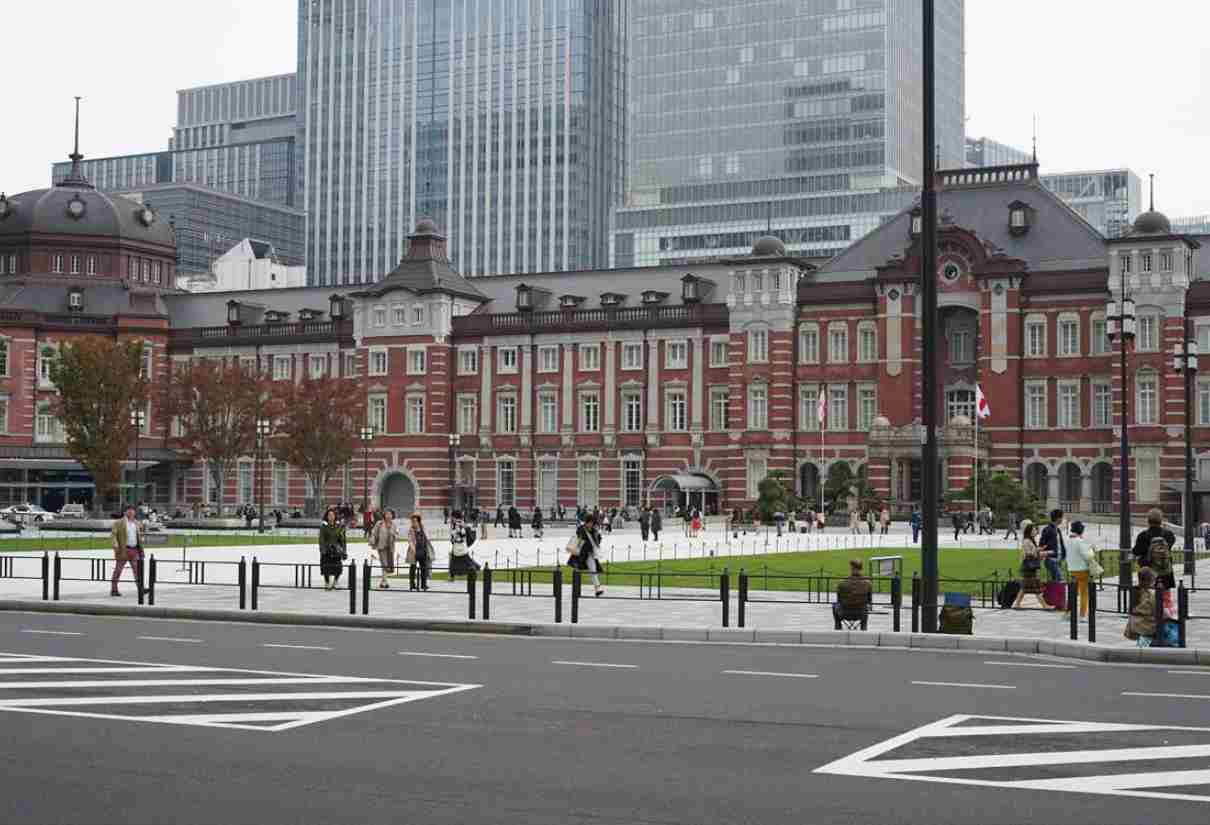
▲ The west side of Tokyo Station was restored for the 2014 centenary of the building.
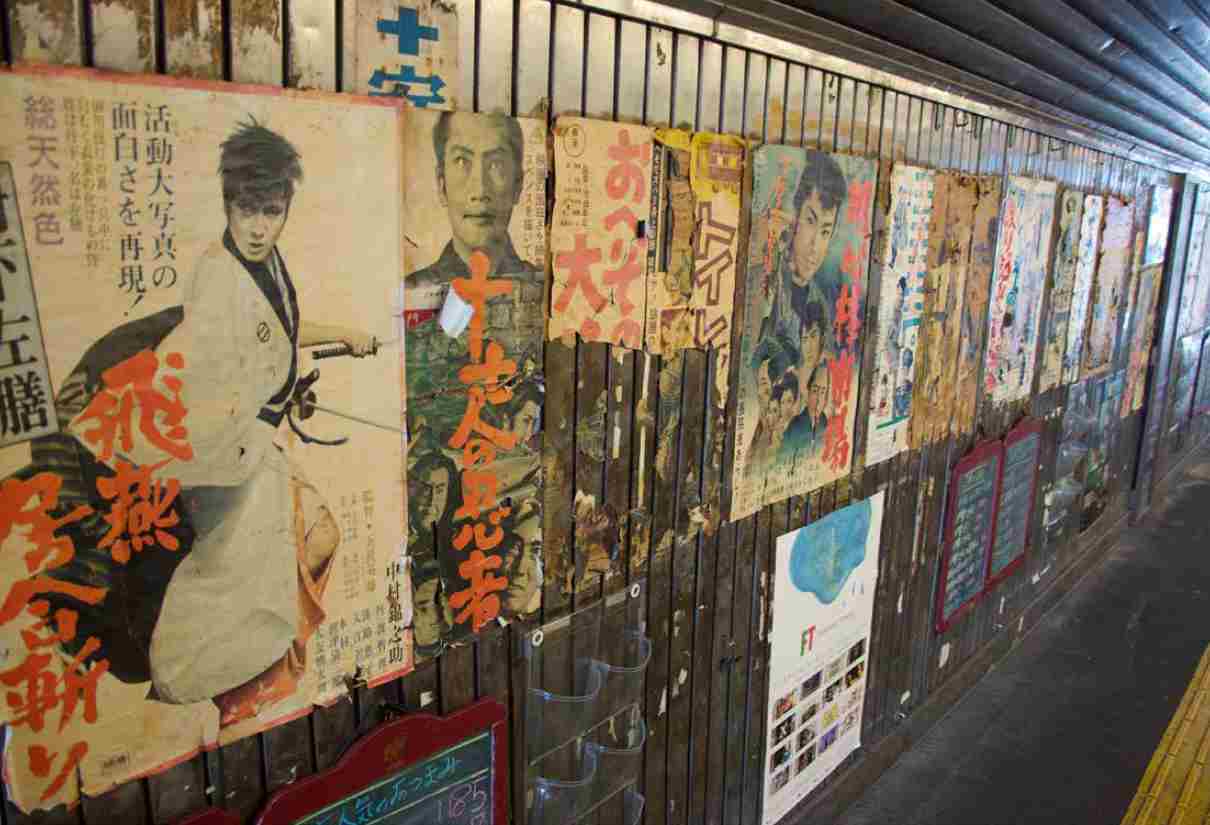
▲ Old movie posters and eateries line this passageway under the tracks in Yūrakuchō.
MARUNOUCHI TO NAGATACHŌ DETAIL 3
 Hibiya Park / Hibiya Kōen 日比谷公園
Hibiya Park / Hibiya Kōen 日比谷公園
When Tokugawa Ieyasu entered Edo, this area was an inlet off the bay. As part of his building of Edo Castle, the inlet was filled in to reduce the risk of warships approaching within cannon range. Later in the Meiji period this area was considered as a location for government ministry buildings. However, excavations showed the soil was unfit for heavy modern construction so the government gave the land to the city to use as a park. In 1903 it opened as Tokyo’s first Western-style park, which came to be surrounded by Western-style government buildings. In 1905 some 30,000 protesters gathered in the park in a rally against the conditions of the Treaty of Portsmouth, which ended the 1904–05 Russo-Japanese War. Many saw the treaty as very unfair to the victorious Japanese. In World War II the metal ornaments of the original park were stripped by the Japanese government to be melted down and made into military hardware. After World War II, GIs looking to relax would head to Yūrakuchō for movies at the Ernie Pyle Theater or for the pam pam girls; others would head in the opposite direction to Hibiya Park to pick up young Japanese men. Needless to say GHQ did not approve of such behavior and the MPs would periodically catch violators, who would then be transferred back home. The famous 1951 novel Forbidden Colors by Mishima Yukio has mention of Hibiya Park as a gay pickup spot.
Today the park is known for other kinds of colors, having a famous rose garden and a tulip garden. Each November the park is host to the Tokyo Metropolitan Chrysanthemum Exhibition.
 https://www.tokyo-park.or.jp/park/format/index037.html
https://www.tokyo-park.or.jp/park/format/index037.html
 Ministry of Justice Museum / Hōmu Shiryō Tenjishitsu 法務史料展示室
Ministry of Justice Museum / Hōmu Shiryō Tenjishitsu 法務史料展示室
The exhibits in the Ministry of Justice Museum cover historical materials on Japanese law from the Meiji period to the present, as well as items related to the construction and restoration of the building. The museum is located on the third floor of the Old Ministry of Justice Building; admission is free.
 http://www.moj.go.jp/ENGLISH/mojm-01.html
http://www.moj.go.jp/ENGLISH/mojm-01.html
 Old Ministry of Justice Building / Hōmu Shōkyū Honkan 法務省旧本館
Old Ministry of Justice Building / Hōmu Shōkyū Honkan 法務省旧本館
This building was designed by the German architects Hermann Ende and Wilhelm Böckmann, with modifications to the plans by Kawai Kōzō. Built in the German neo-Renaissance style, it is one of the few large buildings of this style remaining in the world, as Germany’s were destroyed in World War II. Construction of the building was begun in 1888 and completed in 1895. High standards insisted on by the Germans, such as steel reinforcement and a solid foundation in the soft soil, allowed it to survive the Great Kantō Earthquake. The building was heavily damaged in World War II, losing the roof and interior floors. Extensive work was done starting in 1991 to restore the building to its original look. Today, one half houses the Research and Training Institute of the Ministry of Justice, the Ministry of Justice Library, and the Ministry of Justice Museum; the other half is the Public Prosecutors Offices.
 Tokyo Metropolitan Police Department / Keishichō 警視庁
Tokyo Metropolitan Police Department / Keishichō 警視庁
Designed by Okada Architect and Associates and completed in 1980, the headquarters building is on a V-shaped plot of land and has twenty-two stories, four of which are below the ground level. The Tokyo Metropolitan Police functions as the local police for Tokyo and also handles security for national government facilities, the imperial family, and visiting dignitaries. They have advanced rescue teams for disasters, a unit to fight organized crime, an anti-terrorism unit, and much more. The building is a major landmark often seen in police dramas. As the building’s location is in front of that gate, it is often indirectly referred to as Sakurada Mon.
DETAIL 4
 Japan Sake and Shōchū Information Center / Nihon no Sake Jōhōkan 日本の酒情報館
Japan Sake and Shōchū Information Center / Nihon no Sake Jōhōkan 日本の酒情報館
This is a center devoted to sake, shōchū, and awamori, Japan’s major native alcoholic beverages. There are informational displays on the history of these beverages in Japan, manufacturing techniques, and a variety of implements used in drinking and storing them. About fifty different beverages are available for tasting. They also provide tourist information on breweries that can be visited, sake events, recommended shops, and more.
 https://japansake.or.jp/sake/en/
https://japansake.or.jp/sake/en/
MARUNOUCHI TO NAGATACHŌ DETAIL 4
DETAIL 5
 National Diet Building / Kokkaigijidō 国会議事堂
National Diet Building / Kokkaigijidō 国会議事堂
Designed by Ōkuma Yoshikuni and Yabashi Kenkichi, this steel-framed granite structure took seventeen years to complete, starting in 1920. It is located on the site of the former estate of daimyō Ii Naosuke, who was assassinated at the Sakurada Mon of the palace grounds in 1860. Visitation to the building is restricted; the web sites of the House of Representatives and the House of Councilors each have instructions on how to visit arrange a visit to their respective portions of the building.
In the iconic 1954 movie Gojira (known in the United States as Godzilla), the title character is seen walking through part of the Diet building, leaving it in ruin.
House of Representatives:
 http://www.shugiin.go.jp/internet/index.nsf/html/index_e.htm
http://www.shugiin.go.jp/internet/index.nsf/html/index_e.htm
House of Councilors:
 http://www.sangiin.go.jp/eng/index.htm
http://www.sangiin.go.jp/eng/index.htm
MARUNOUCHI TO NAGATACHŌ DETAIL 5
 National Diet Library / Kokuritsu Kokkai Toshokan 国立国会図書館
National Diet Library / Kokuritsu Kokkai Toshokan 国立国会図書館
In 1948 the collection of the National Diet Library was established by merging the collections of the Imperial Library, the library of the House of Peers, and the library of the House of Representatives. The functions of the library are modeled after the United States Library of Congress and perform a variety of services for the Diet, in addition to collecting and cataloging material published in Japan and about Japan. The current central building dates from 1961. The annex addition was completed in 1986. Members of the public over the age of eighteen can visit the library and gain access to the materials after registering. The library also has exhibits, free wi-fi, a cafeteria, a coffee shop, and a kiosk to purchase stationery and food.
DETAIL 6
The founding date of this shrine is unclear. Edo Shigenaga built a Hie Jinja in the Kamakura period, as Ōta Dōkan did later when he built his castle in 1478. Some scholars think it is the Sannō Jinja mentioned in a document from 1362. Before the separation of Buddhism and Shintō in the Meiji period, Hie Jinja was also referred to as Sannō Sama. The reason for this is that Ōyamakui no Kami, the kami enshrined there, was also referred to as Sannō Gongen. In any case, it is an old shrine that has long been considered the protector of Edo castle, and after the shōgun left, the protector of the Imperial Palace. Tokugawa Ieyasu had the shrine moved to the southwest, where the Supreme Court is now. After the shrine burned down in the Meireki Fire it was rebuilt on the hill where it now resides. The shrine was last destroyed in the firebombings of World War II; the present buildings date from 1958. As the messenger of Sannō Gongen is the monkey, there are statues of monkeys at the main entrance and in front of the main hall. During the Sannō Matsuri, held in June every other year, the procession is allowed to enter the palace grounds, a tradition that dates back to the Edo period. There is a shrine museum to the right of the main hall.
The main entrance is to the east via a stairway with an impressive torii. There is also a steeper, narrower stairway on the west side.
 https://www.hiejinja.net/english/index.html
https://www.hiejinja.net/english/index.html
MARUNOUCHI TO NAGATACHŌ DETAIL 6
